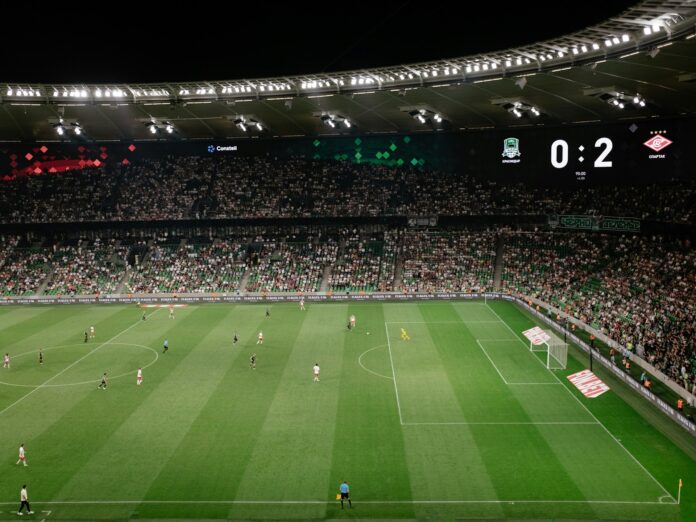By Maxim Evstigneev, Takhir Kholikberdiev & Ivan Bakulin
In the spring of 2022, Russian football looked as though it had been locked in a windowless room and left to survive on its own. No European competitions, international transfers severely complicated. And yet, if you take a closer look in 2025, there is a surprising vibrancy beneath the surface. Academies are being built, talents are being scouted from the far corners of the world, and unexpected champions are rising.
No one saw it coming, but now Russian football seems more itself than ever not glossy, but strikingly alive.
When Zenit Isn’t the Champion
A few match days before the end of the season, many fans were rubbing their eyes in disbelief, Zenit wasn’t leading the table? No, they weren’t. The title went to Krasnodar. Once dismissed as the “plaything” of businessman Sergey Galitsky, the club has proven itself to be more than a well-funded project. It’s a team with a philosophy and grit. Their Premier League triumph wasn’t a stroke of luck; it was the result of long-term planning: homegrown players, one of Europe’s most modern stadiums, a world-class academy, a homegrown and tactically astute manager Murad Musayev, and most importantly patience.
In just 17 years, Krasnodar has gone from a local amateur team in southern Russia to the champions of a vast nation.
A Billion-Euro Pulse
They said the money would dry up. They were wrong. In 2024, Russian clubs earned approximately €1.5 billion. It’s not the oil-fueled era anymore, nor the age of unlimited contracts, but the money is still there and it’s circulating.
Zenit continues to spend as they always have over €40 million in the winter transfer window alone. Spartak went even further, investing around €50 million. Krasnodar, true to its ethos, spent less but smarter, selling players for $35 million. Across the league, a record-breaking €150 million was spent on incoming players.
Russian football has become an internal market closed off, but highly active. It is no longer a shop window for Europe, but a self-contained ecosystem with its own economy, logic, and even trends.
Where They Play, They Build
Every club is building something. The legacy of the 2018 World Cup is no longer a legacy it’s the new normal. Krasnodar boasts a stadium any international agent would be proud to visit. In Kazan, Moscow, St. Petersburg, Samara, and Sochi, the infrastructure is good enough to host Champions League-level matches. Despite sanctions and the withdrawal of European contractors, clubs are not halting development.
Russian football is investing in what can’t be devalued: infrastructure, pitches, and youth.
Brazilian Blood and a PSG Export
While Europe looks away, South America opens its doors. This season has seen a wave of young Argentinians, Uruguayans, and Colombians arrive in Russia players whose value in Europe would be much higher, but who can grow even more in the RPL.
Budgets vary, but even lower-tier RPL clubs are spending between €500,000 and €2 million on foreign players. Top clubs are ready to invest tens of millions when it comes to talent with the potential to become key players and lift the team in the standings. Spartak’s €14 million signing of Barco wasn’t just a hefty price tag it was a statement: we’re still here to play. Zenit now spends more in Latin America than some Serie A clubs like the recent €33 million signing of winger Luiz Henrique from Botafogo.
When recruiting foreign players, Russian clubs focus not just on stats, but on personality mental toughness, adaptability, and football IQ. A technically gifted but mentally fragile player won’t last long. This makes it essential for agents to assess not only a player’s skills but also their psychological profile and readiness for a different culture, climate, and footballing philosophy.
As for exports, business is good there too. Krasnodar sold goalkeeper Matvey Safonov to PSG for €20 million. And this summer, a serious bidding war is expected for academy graduate and team captain Eduard Spertsyan, also the captain of Armenia’s national team, who’s now on the radar of Leeds United, Juventus, and several La Liga clubs. In a closed-off league, big deals still make noise.
Agents Are Back in Business
When things get complicated, the people who know how to negotiate become invaluable. That’s why this is a golden era for agents. Commissions are up, but so are the demands. Unlike Europe, Russia still places a premium on human relationships and internal dynamics. Cultural fluency, trust between agent and sporting director, and the ability to “walk into the right room the right way” often matter more than data from Wyscout.
In Russia, the transfer market doesn’t just value hard analytics, it rewards trust-building, contextual intelligence, and navigating a complex club and cultural ecosystem.
Scouting in Russia isn’t just about metrics; it’s about reading between the lines and understanding the human behind the player. In such a market, the agent becomes a key mediator connecting the club, the player, and the player’s home country. This makes the system flexible, dynamic, and resilient against one-size-fits-all solutions.
Why Good Players Still Want to Come to Russia
Because here, they can become central figures not just squad players. Because contracts are stable, salaries are competitive, infrastructure is top-tier, and their contributions are genuinely valued. In an era where many leagues are overcrowded or dictated by algorithms, Russia remains a place where personality and performance still hold sway.

